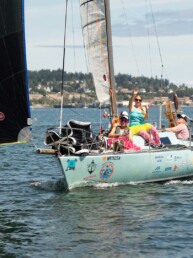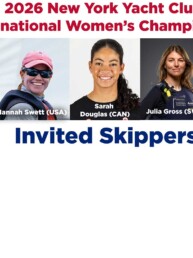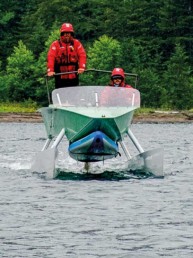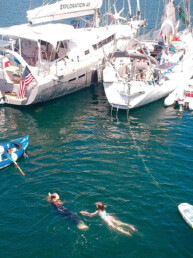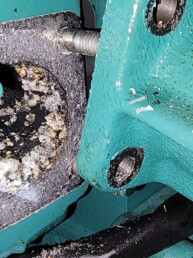One of the classic races on the Royal Ocean Racing Club’s calendar is the Cowes Dinard St. Malo Race. This 151-mile jaunt across the English Channel to St. Malo, France, has been held annually for nearly 100 years. This year it was also the first leg of the IRC Double-Handed European Championship, so Red Ruby was keen to put down a decent score.
While the course looks simple on a chart, the tactics for the middle part of the race have challenged participants for decades, with the shifting winds and strong, swirling currents around the Channel Islands presenting a minefield of opportunity and disappointment. Last year on Red Ruby, a Jeanneau Sun Fast 3300, we were having a great race until we arrived at Casquets, a group of rocks eight miles northwest of the island of Alderney, where we lost our lead to boats whose skippers read the current more astutely. Could this year be our redemption?
After finishing the La Trinité-sur-Mer to Cherbourg race (see last month’s column), I was keen to get to Cowes on the Isle of Wight, where the next race would start. I dropped off my crew, Olivier, and headed back to sea straight away, hoping to cross the channel in daylight. The wind, a 20-knot westerly, was perfect for a fast passage.
The problem is that I was really tired, not having slept much in the previous three days. I got sloppy with my navigation leaving the harbor, getting too close to some submerged piles, remnants of World War II bombing of the harbor. As I started to hoist the main, I heard a bang, then felt the boat slow. Crap. As I backed out of the foul water, I was cursing my poor seamanship and hoping I had not damaged our boat. I quickly took stock. There was no water coming in, and all systems seemed to be OK. Fortunately, I was going quite slowly. Maybe I got lucky with just a few scratches on the keel, I thought.
Chastened, I got the sails up, set a course for the Isle of Wight 70 miles to the north, and took a series of short naps to try to recover from the previous race. I had quite a short recovery period before the next race started in two days. By the time I could see the Needles, the distinctive row of chalk stacks marking the western approach to the Solent channel, I had put a few 20-minute naps together and was feeling better.
I cleared customs (no more open borders between the U.K. and France) and got into the marina in West Cowes without further incident, but still cursing my blunder. The next day I hired a diver to survey the keel damage. The diver told me it “didn’t look too bad” and described some scrapes and dings at the corners of the keel. No big deal, I thought, hoping to minimize the incident in my mind.
My partner for this race was my friend and boat partner Justin Wolfe. Though I own the boat in partnership with Justin and his wife Chris, we never sail together because they race together as a team. I typically have another partner, often Alyosha Strum-Palerm. But Alyosha couldn’t make this one, so Justin agreed to fill in.
After he arrived in Cowes, we finished preparing the boat and started looking at the weather. It was going to be windy! The forecast was calling for 20 to 30 knots upwind out of the Solent, then a little lighter across the channel, only 20 to 25 knots. But another front was forecast to arrive at the Channel Islands, with 30 to 35 knots and big seas. Seeing this, a number of boats chose not to race, including the top French doublehanders and a few of the U.K. boats.
The start was exciting. Justin put us in a great spot near the leeward end, and off we went up the Solent with a reefed main and #3 jib. But just a couple of minutes after the start, all the electronics on the boat stopped working. While short tacking upwind in 25 knots of wind, we tried the obvious solutions, but no luck. Finally, we started the engine and the charge brought the electronics back to life. We were back in business!
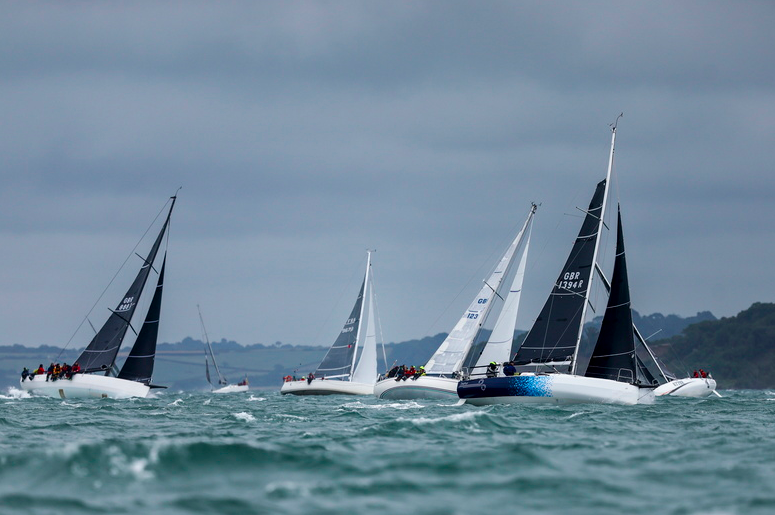 We sailed OK for the 12 miles past the Needles and into the channel. We weren’t quite as fast as we were used to, but no big mistakes were made. We were in the middle of our group of doublehanders, but weren’t gaining on the leaders. We sailed upwind for the next 18 hours, tacking on the tide change. As night fell, we were still in the middle of our fleet, with the Channel Islands and the frontal passage ahead.
We sailed OK for the 12 miles past the Needles and into the channel. We weren’t quite as fast as we were used to, but no big mistakes were made. We were in the middle of our group of doublehanders, but weren’t gaining on the leaders. We sailed upwind for the next 18 hours, tacking on the tide change. As night fell, we were still in the middle of our fleet, with the Channel Islands and the frontal passage ahead.
Just before dark, we changed from the #3 to the #4 jib in anticipation of the building breeze. Sure enough, just as we got close to Alderney, the wind built from 20 to 35 knots and the waves got big and confused. The wind also went right, but not enough for us to lay Les Hanois, the lighthouse at the western edge of the Channel Islands. The boats to the west of us, including the leaders, benefited from better tide and a better position in the shift. As dawn broke, we were finally approaching Les Hanois, where we could bear away onto a reach. We had done pretty well overnight against the boats behind us, but the leaders had stretched from two miles to 10 miles ahead and we were a little too far east when the shift came. Darn it!
The 40-mile reach from Les Hanois to the finish was one to remember. We could see three boats in our class ahead of us, and we knew some slower-rated boats were close behind. We were determined to claw back to a respectable finish, and reaching played to our strength. First we went back to the larger #3 jib, then we unreefed the main. We were bombing along at 10 to 12 knots in big seas, but the wind was slowly lifting. Time for the Code Zero! We got it up before any of the boats around us and really took off. Now we were doing 12 to 14 knots and gaining on everyone—maybe steering a little low of the finish, but still worth it. At one point I got too low on a wave and broached to leeward. The mainsail came across and knocked me over. I hit my head on the stanchion but recovered the tiller in time to get back on course without further strife. I was bloody but not done yet—this blast reaching was too much fun! 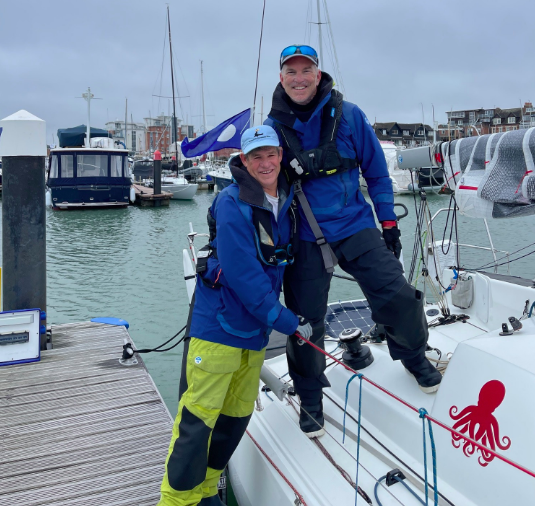
We ended up passing four boats in our class on that leg, and nearly got one more. In the end we were fifth in our class. That seemed a little disappointing, as we had sailed pretty well, without major errors. But the leaders had better conditions at the end, and with our slight speed deficit, we couldn’t quite get to the front. We fought hard, though, sent it at the end, and got what later turned out to be a crucial score for the first leg of the European championship. The second leg will be the subject of our next report!
I’m grateful to Justin for flying over to race with me. We had a great time together in the challenging conditions. He is truly an excellent heavy weather sailor and a great shipmate.
Images courtesy of Jonathan McKee and Paul Wyeth/RORC.

